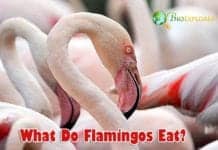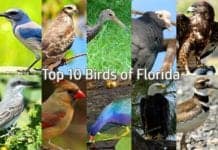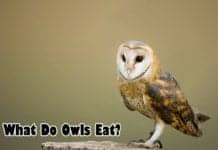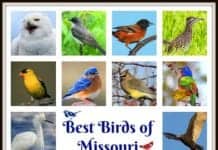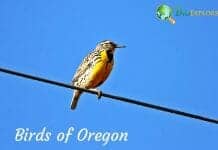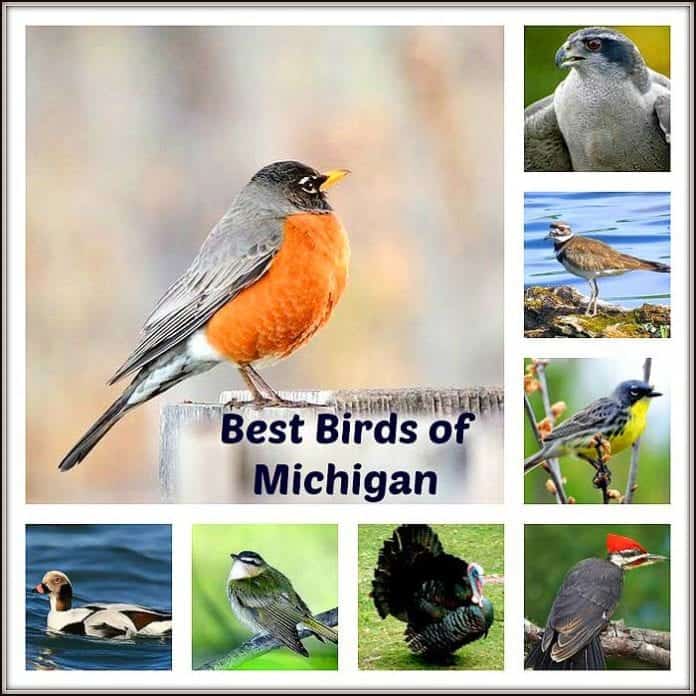
Birds of Michigan: The state of Michigan has a variety of habitats that are inviting for different Bird Species.
The lakes and marshes are home for the elegant waterfowl, grasslands are an excellent lure for the pheasants and grouse, while the seashores invite some unique bird species as well.
Big and small species of forest birds can visit your feeder in summer or winter. The fifteen species presented here can give you a clue about the “flying” biodiversity of this state.
In this page, let us explore the exciting birds of Michigan and their interesting facts.
Table of Contents
Best Birds of Michigan
1. American robin
| Animalia | Passeriformes | Turdidae | Turdus | Turdus migratorius |
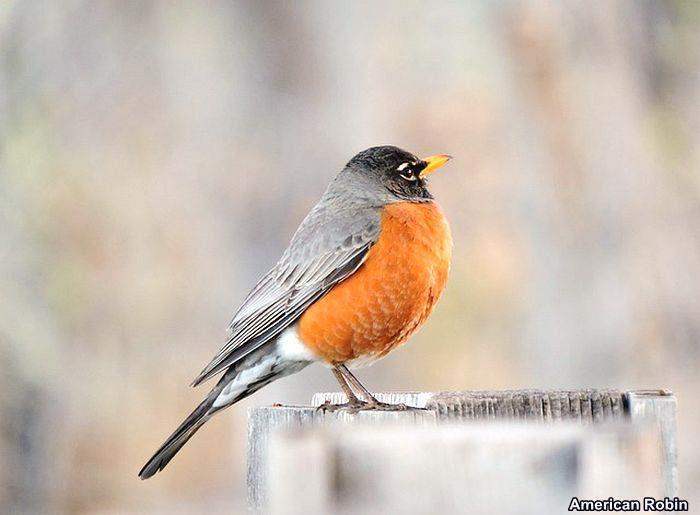 The first bird of Michigan on our list is American robin. An American robin is a thrush with a round body and a long tail.
The first bird of Michigan on our list is American robin. An American robin is a thrush with a round body and a long tail.
- This bird has long legs as well. The most prominent feature of this robin is the bright orange chest.
- The upper body of the American robin is gray, with a black head and a yellow bill.
- There are also white marks around the eyes.
Interesting Facts about American Robin
- An American robin is proclaimed the state bird of Michigan.
- The American robin is North America’s largest and most abundant thrush.
- An American robin has at least two types of songs.
- The eggs of an American robin are blue-colored.
- This state bird of Michigan is still actively studied despite being quite common in the area.
![]()
2. Kirtland warbler
| Animalia | Passeriformes | Parulidae | Setophaga | Setophaga kirtlandii |
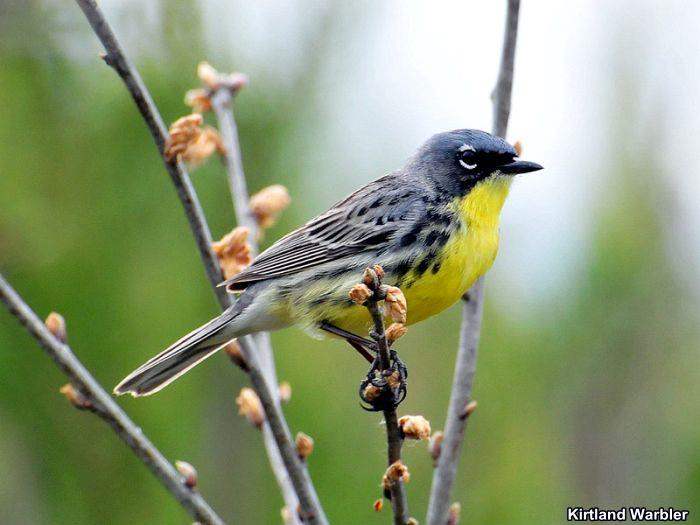
- It is a small, elegant bird with contrasting plumage.
- The upper parts of the body are blue-gray, while the chest is lemon yellow.
- These birds in Michigan also have a distinct white incomplete ring around the eyes.
- The female Kirtland warblers have less bright coloring, with the addition of brown feathers.
Interesting Facts about Kirtland Warblers
- This bird feeds in the jack pine forests of Michigan and Wisconsin.
- The Kirtland warbler is both one of the largest and the rarest warblers in North America.
- Kirtland warblers cannot feed without forest fires – without heat, jack pine cones do not open up and release their seeds.
- The Kirtland warbler prefers to nest in the new growth that appears after forest fires.
- One of the main contributors to the decline of the populations of Kirtland warblers is the parasitic bird called brown-headed cowbird.
![]()
3. American coot
| Animalia | Gruiformes | Rallidae | Fulica | Fulica americana |
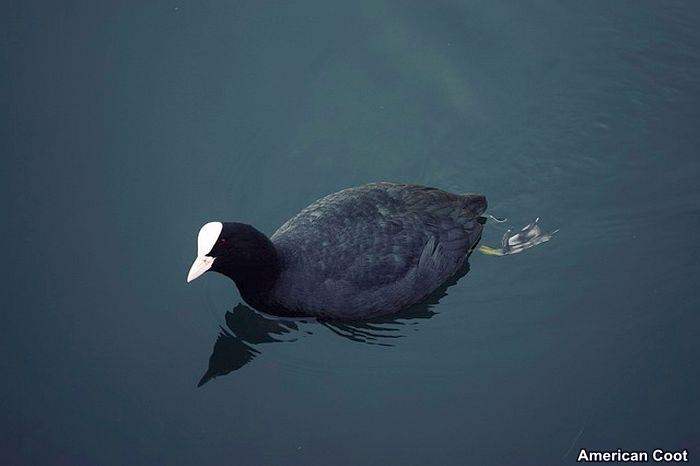 The next Michigan bird is a charismatic and very adaptable water bird.
The next Michigan bird is a charismatic and very adaptable water bird.
- American coots prefer to live in wetlands and lakes, including the Great Lakes.
- An American coot is a stocky bird with black-grey plumage. The head of the American coot is usually darker than the rest of the body.
- This waterbird has a contrasting, white bill that extends to form a “shield” on the forehead.
- There can also be a red-brown patch on the apex of the “bill shield“. The eyes of the American coot are red.
- These birds have strong, greenish-gray legs adapted for swimming.
Interesting Facts about American Coot
- It is the only species of coot in the North and Central America.
- American coots are known as aggressive and territorial birds.
- American coots can be occasionally seen in the small ponds at golf courses.
- American coots are known to steal food from other ducks;
- The nests of the American coots are floating platforms made from marsh plants and anchored to sturdy standing water plants.
![]()
4. Killdeer
| Animalia | Charadriiformes | Charadriidae | Charadrius | Charadrius vociferus |
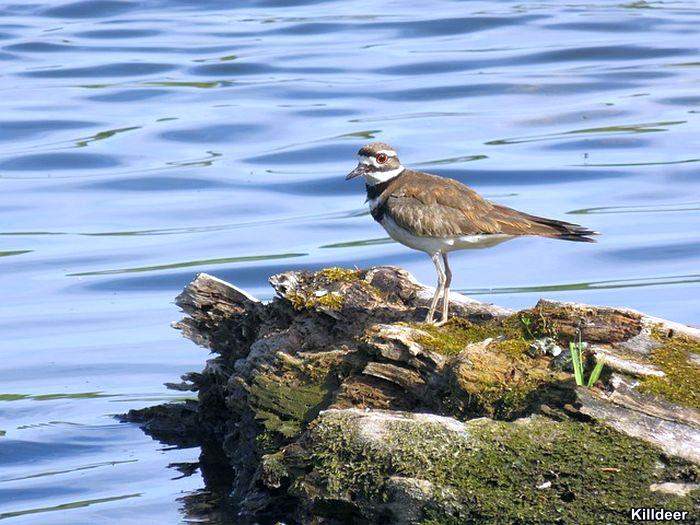 A killdeer is related to plovers. It is a shorebird with long, graceful legs and a short bill, typical for plovers.
A killdeer is related to plovers. It is a shorebird with long, graceful legs and a short bill, typical for plovers.
- The wings and the tail of the killdeer are long. The killdeers have a brown back and brown wings.
- The underside of the wings is striped.
- These birds also have a white belly and a white chest with two distinct black stripes.
- Killdeers prefer to feed on open ground.
Interesting Facts about Killdeers
- The killdeers previously had two different common names: chattering plover and noisy plover.
- The human activity influenced their behavior, as they began to frequent meadows with short grass and golf courses. They also can be seen near construction sites.
- Killdeers have a unique gait that combines running with bobbing.
- These birds are famous for their “broken wing act” – one of the parents pretends to be injured to lead the potential predator away from the nest.
- When the killdeer is faced by a hoofed animal that can potentially trample their nest, they puff up their feathers and run at the intruder head-on.
![]()
5. Red-eyed vireo
| Animalia | Passeriformes | Vireonidae | Vireo | Vireo olivaceus |
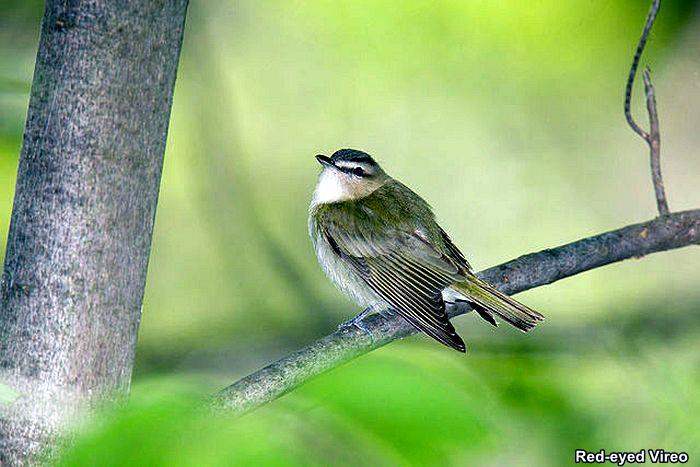
- The head of the Red-eyed vireo is darker than the rest of the body, and there is a dark stripe that goes through the eye region.
- The red eyes of this vireo are not particularly noticeable and can seem brown.
- The bill of this bird is short and relatively sick.
Interesting Facts about Red-eyed Vireos
- This bird can be often found in the eastern woods of North America.
- This small songbird hides in the treetops and is rarely seen.
- The red-eyed vireo has a particular repetitive song that seems as if the bird is continually asking the same “question“.
- The population of this species had declined previously when the forests of the East USA were being cleaned. Now, this species is considered stable and not under threat.
- Red-eyed vireos cooperate with chickadees and warblers during migrations.
![]()
6. Long-tailed duck
| Animalia | Anseriformes | Anatidae | Clangula | Clangula hyemalis |
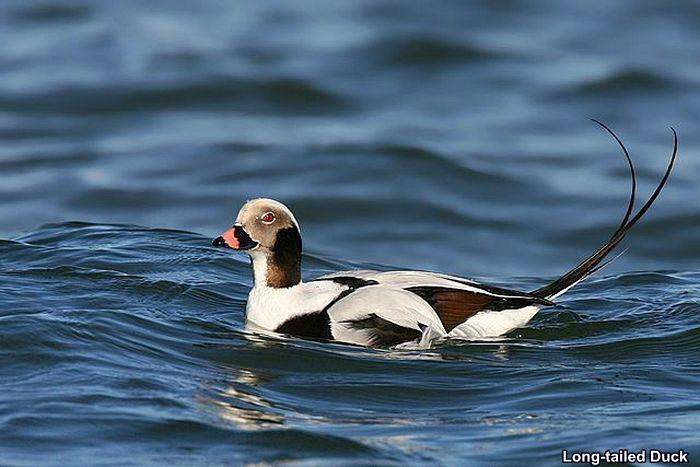
- This duck has a white head and plumes covering a brown back.
- The bill is black. In male ducks, the short black bill has a red stripe.
- Female ducks lack white plumes and have an overall brown body.
- These ducks can be seen in freshwater lakes, such as Lake Michigan, and coastal sea waters in the northern areas.
Interesting Facts about Long-tailed Ducks
- When the male long-tailed ducks are ready for breeding, they develop a black hood over the head, with a white area around the eyes.
- The long-tailed ducks have different plumage in summer and winter.
- The main predators for these birds of Lake Michigan are Arctic foxes and several species of gulls.
- Long-tailed ducks have different calls for different situations: breeding, conversing with their young, flying in a flock, and so on.
- Meat and eggs of long-tailed ducks are part of the diet of some Inuit communities.
![]()
7. Northern bobwhite
| Animalia | Galliformes | Odontophoridae | Colinus | Colinus virginianus |
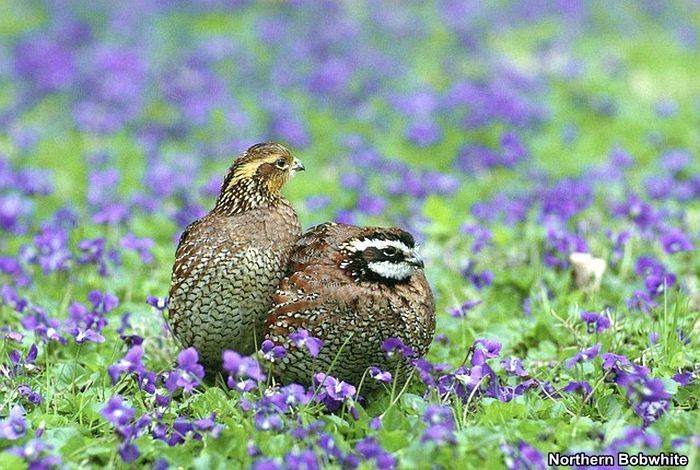 This next bird of Michigan is a small bird that resembles a chicken. It has a plump body and a short tail.
This next bird of Michigan is a small bird that resembles a chicken. It has a plump body and a short tail.
- Males have an intricately patterned plumage with a mix of brown, chestnut, black, and white.
- The males have distinct black and white stripes on their faces.
- The females have plumage mostly in brown shades and lack the face stripes.
- The bill of the northern bobwhite is long and curved.
- The state of Michigan is the northern range of this species, and it is often referred to as “Michigan quail“.
Interesting Facts about Northern Bobwhite
- The common name of the species comes from the whistle this quail produces: “bob-white“.
- The plumage of this quail is an excellent camouflage that helps the birds to hide in the grasslands.
- There is an increasing concern about the decline in the northern bobwhite populations.
- Northern bobwhite tends to forage and roots in small groups for safety.
- Sometimes, the female bobwhite can leave the male to tend to the eggs and make a new nest with eggs elsewhere.
![]()
8. Eastern wild turkey
| Animalia | Galliformes | Phasianidae | Meleagris | Meleagris gallopavo silvestris |
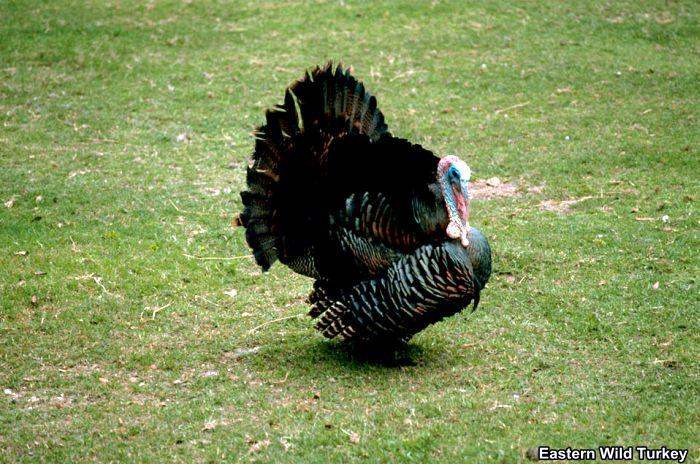 This Michigan bird is one of the six species of the Northern America wild turkeys.
This Michigan bird is one of the six species of the Northern America wild turkeys.
- This large game bird inhabits the east of the continent.
- It can be differentiated from other turkey species by the chestnut brown tips on the upper tail feathers.
- The birds have overall brown plumage.
- The males have a featherless head with blue and red markings.
- The females are mottled brown. This turkey species is one of the largest – they can grow up to 4 feet.
Interesting Facts about Eastern Wild Turkey
- Eastern wild turkey went almost extinct in Michigan but was successfully reintroduced.
- The female and male turkeys have separate hierarchies.
- The turkeys do not build nests – they lay eggs in underground depressions.
- The newly returned wild turkeys in Michigan were reported to damage crops or nest in the hay fields.
- Female turkeys and young birds form family groups; males form their bachelor groups.
![]()
9. Pileated woodpecker
| Animalia | Piciformes | Picidae | Dryocopus | Dryocopus pileatus |
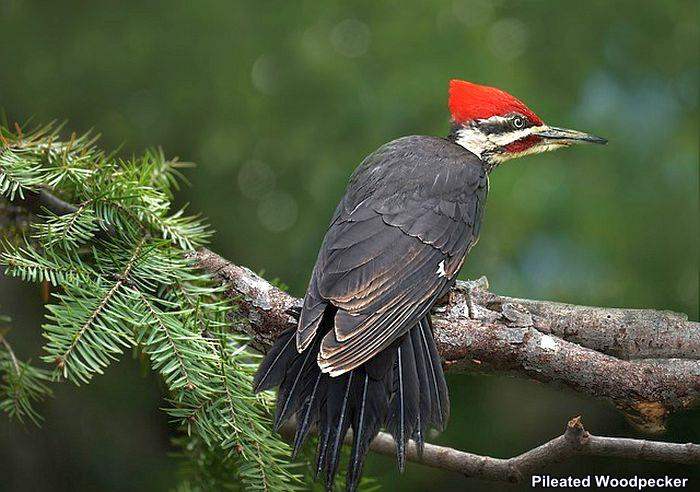 This next bird is the largest woodpecker in Michigan.
This next bird is the largest woodpecker in Michigan.
- Both sexes have a distinct red crest on the head and black stripes on the face.
- The only distinct feature of the male pileated woodpecker is the presence of a red stripe on each cheek.
- The body of the pileated woodpecker is mostly black, and only in-flight one can see white stripes on the edge of the wings.
- These birds also have white underwings.
- These woodpeckers have a long neck and a long, heavy bill suitable for getting insects from the tree bark.
Interesting Facts about Pileated Woodpeckers
- Pileated woodpeckers tend to make typical rectangular holes in the trunks of rotting trees in search of insects;
- When seen in flight, pileated woodpeckers may be mistaken for crows because of their distinct flight style.
- These woodpeckers need standing dead trees that may contain insects.
- Due to extensive deforestation, these birds have gone almost extinct in Michigan at the end of the 19th century.
- Recently, these birds were seen returning to the previously abandoned areas, as they have adapted to living in smaller forest areas in parks and cemeteries.
![]()
10. Great Blue Heron
| Animalia | Pelecaniformes | Ardeidae | Ardea | Ardea herodias |
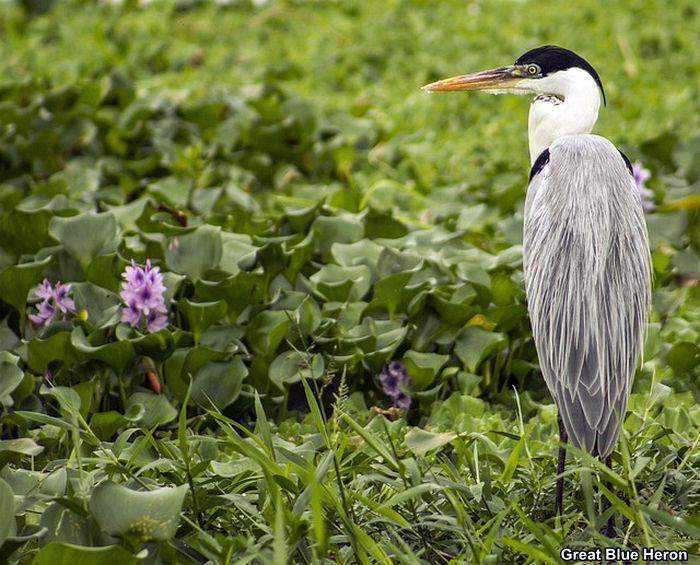 The great blue heron is an awe-inspiring bird.
The great blue heron is an awe-inspiring bird.
- Great blue heron can grow up to 60 cm tall, and the body length of the bird can reach about 137 cm.
- Like most Herons, the great blue has a graceful, – S-shaped neck and a long, needle-like bill.
- The legs of the great blue heron are long and slender, adapted to water foraging.
- The overall body color of the great blue heron is gray-blue, but black, white, and brown stripes are on the head and neck.
- The bill and heron’s legs can be yellow-green or gray. The wings of this heron are broad and rounded, and the tail is short.
- There is a plume of black feathers on the necks of adult herons.
- The males and females are similar, with the males slightly bigger.
Interesting Facts about Great Blue Herons
- Great blue herons’ nest in colonies.
- Great Blue Herons can be spotted in the spring-summer in the Great Blue Heron Rookery in the Shelby township.
- Great Blue Heron is the largest heron in North America.
- The herons can stand still for hours in the water, waiting to catch fish.
- Herons are known to leave the area where the predator attacked their chicks or adult birds.
![]()
11. Eastern whip-poor-will
| Animalia | Caprimulgiformes | Caprimulgidae | Antrostomus | Antrostomus vociferus |
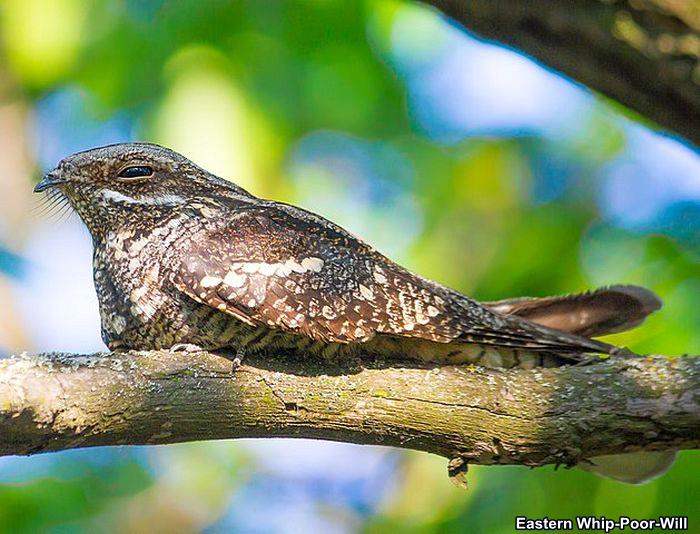
- The coloring is complicated, mixing brown, black, grey, and rusty brown.
- There is a white bib on the lower part of the chest and a small plume of grey feathers on the back.
- The male whip-poor-wills have a broad white tail corner visible during flight.
Interesting Facts about Eastern Whip-poor-will
- The eastern whip-poor-wills are entirely nocturnal birds.
- These birds are known to sing continuously through the night, the call resembling the name – “whip-poor-will“.
- The coloring of these birds makes an excellent camouflage – it is tough to spot a whip-poor-will even in the daylight.
- The whip-poor-wills nest on the ground.
- These birds are extremely hard to study – their first nests were found only in 1980 -1994 in different states.
![]()
12. Ruby-throated hummingbird
| Animalia | Apodiformes | Trochilidae | Archilochus | Archilochus colubris |
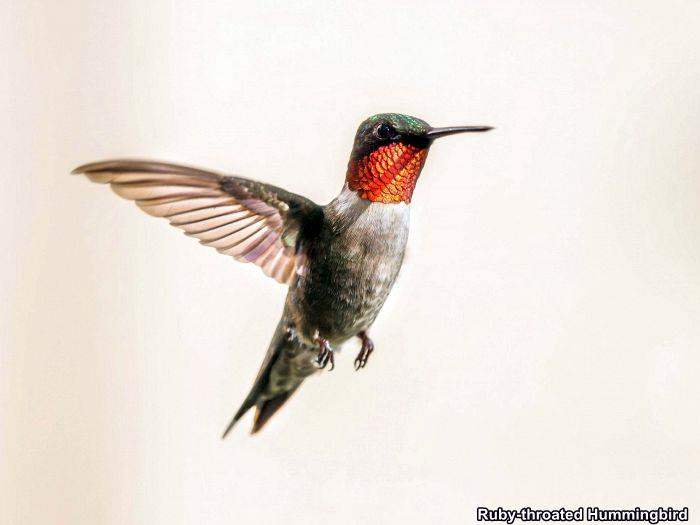 This beautiful bird can often be seen around hummingbird feeders in Michigan.
This beautiful bird can often be seen around hummingbird feeders in Michigan.
- It is a tiny bird with an emerald green back, luminous red throat, and white-grey chest.
- The red throat with a contrasting black mask is present only in males.
- The females of this species are less bright – with a greenback, white belly, and spotted grey mask.
- These hummingbirds in Michigan have a long, slender bill with a slight down curve. They also have short wings and a relatively short forked tail.
Interesting Facts about Ruby-throated Hummingbirds
- The ruby-red throat of the male ruby-throated hummingbirds is iridescent: it can look either red or black depending on the angle of the light.
- These hummingbirds can feed both on nectar and insects.
- During their migrations in spring and fall, these hummingbirds fly 500 km nonstop over the Gulf of Mexico.
- A male ruby-throated hummingbird weighs less than a U.S. penny.
- This bird is the only hummingbird that regularly breeds in the northern states of the USA, including Michigan.
![]()
13. King rail
| Animalia | Gruiformes | Rallidae | Rallus | Rallus elegans |
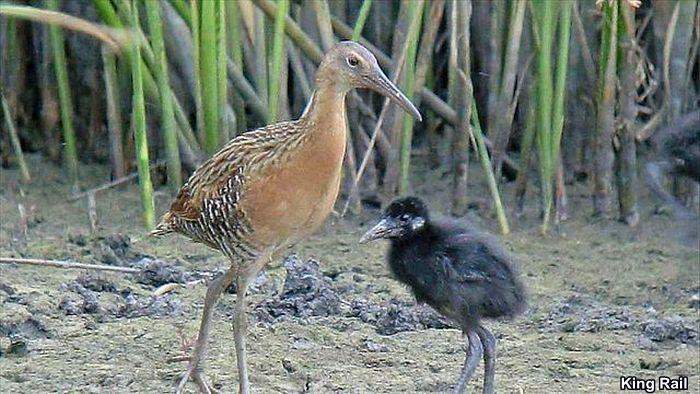
- It is about the size of the chicken. This bird looks elegant- its plump body, slender neck, and round head.
- The bill of the king rail is long with a small curve.
- The king rails are good walkers with long, strong legs.
- The king rails have the overall mottled rusty coloring of the body besides the white bars on the flanks.
- The tail of the king rail is very short and often held proudly up during walking.
Interesting Facts about King Rails
- The chicks of the king rail are colored black.
- After laying the eggs, the female king rail molts and loses its feathers. It becomes flightless for a month during egg incubation.
- The nests of the king rails look like complex platforms that are slightly above the water level. These structures have a small canopy above and a ramp leading to the entrance.
- The king rail has many perquisites for its habitat: it needs marshland with much vegetation. That is why it is becoming rare because of the destruction of marshes in the country.
- If the king rail catches prey on the ground, it dunks it in the water before eating it.
![]()
14. Sandhill crane
| Animalia | Gruiformes | Gruidae | Grus | Grus canadensis |
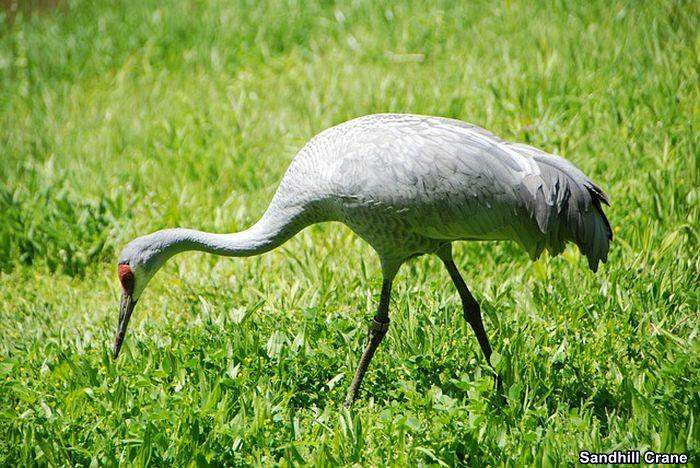 The sandhill crane is a long-legged bird with a long, graceful neck, small head, and long bill.
The sandhill crane is a long-legged bird with a long, graceful neck, small head, and long bill.
- It can be differentiated from a heron by its bulky body and different neck shape.
- There is a distinct red crown on the head. The overall body color is grey mixed with rusty brown.
- There is a bustle of feathers around the tail region.
- The throat of the sandhill crane is white. Sandhill cranes have large wings, seen better in flight.
Interesting Facts about Sandhill Cranes
- Sandhill cranes are believed to be the oldest living birds – some fossils date up to 2.5 million years old .
- The sandhill crane is the largest bird in Michigan.
- A subspecies of the sandhill crane, the Mississippi Sandhill Crane, is considered endangered.
- Unlike herons, sandhill cranes forage for food in grasslands and marshes, not open water.
- To be safe from predators, these large birds of Michigan tend to roost in the middle of the lakes or ponds.
![]()
15. Northern goshawk
| Animalia | accipitriformes | Accipitridae | Accipiter | Accipiter gentilis |
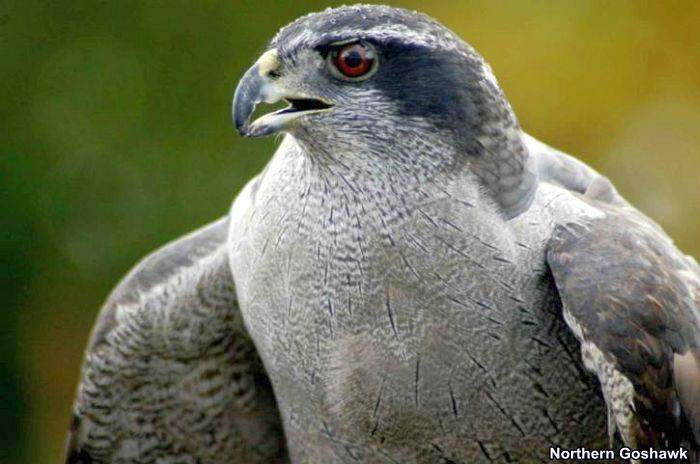 A northern goshawk is a large forest raptor. These northern Michigan birds have large wings and a long tail with a rounded end.
A northern goshawk is a large forest raptor. These northern Michigan birds have large wings and a long tail with a rounded end.
- The upper body is colored in different shades of grey. The head of the goshawk has a black cap.
- These birds of prey in Michigan also have a distinct white stripe slightly above the eye area.
- The lower body is also grey but lighter in the shade with horizontal and vertical streaks.
- There are fluffy white feathers under the northern goshawk’s tail, especially visible during the breeding season.
- Northern goshawks have a short, curved bill typical for predatory birds.
Interesting Facts about Northern Goshawks
- Northern goshawks have a typical call that sounds like ki-ki-ki or kak-kak-kak.
- Northern goshawks are thought to form pairs for life.
- Other predatory birds, such as a great-horned owl or red-tailed hawk, may displace northern goshawks from their nests.
- These birds of prey of Northern Michigan are stealthy predators, hiding in the tree canopy or sitting on the tree branches to surprise their prey.
- Goshawk comes from the Old English word for “goose hawk“, as this bird prey on geese and grouse.
![]()
The bird world of Michigan is very diverse and exciting. Search yourself for birding trails or hang feeders to see some inhabitants.
![]()


